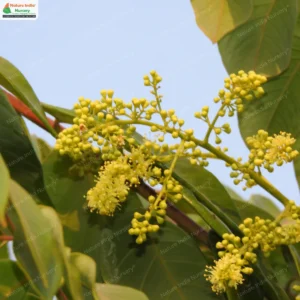Barringtonia asiatica, commonly known as Sea Poison Tree, Fish Poison Tree, or Putat, is a tropical tree native to coastal areas of the Indian Ocean and western Pacific Ocean. It is renowned for its large, fragrant flowers and distinctive box-like fruits that float on water.
The Sea Poison Tree is a medium-sized tree that can reach up to 15-20 meters in height. It has a broad, spreading canopy and glossy, dark green leaves with a leathery texture. The leaves are large and obovate with a pronounced central vein. The tree produces large, white to pinkish flowers that are highly fragrant, especially at night. These flowers are about 105 cm in diameter and consist of numerous long, showy stamens. The fruits are large, square-shaped, and buoyant, capable of floating long distances on water currents, which aids in their dispersal.
Habitat
Sea Poison Tree thrives in coastal and mangrove areas, often found along sandy beaches, estuaries, and riverbanks. It prefers tropical climates with high humidity and can tolerate salt spray and occasional flooding.
Planting and Care
- Light: Full sun to partial shade
- Soil: Sandy, well-draining soil
- Watering: Requires regular watering, especially during dry periods. Tolerates occasional flooding.
- Maintenance: Prune to maintain shape and remove any dead or damaged branches. Mulch around the base to retain soil moisture.
Additional Information
- The tree attracts pollinators such as bats and moths, which are drawn to the flowers’ strong fragrance.
- Propagation is typically done through seeds, which can be sown directly in sandy soil or floated in water until they germinate.
- The seeds and other parts of the tree contain toxic saponins and are used traditionally in some cultures to stun or kill fish, hence the common names.
- Despite its toxicity, the tree is sometimes planted for ornamental purposes due to its attractive flowers and coastal resilience.
Please note: The seeds and other parts of the tree are toxic if ingested. Handle with care, especially around children and pets.




